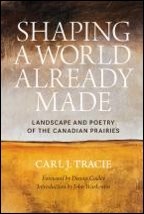By Carl J. Tracie
Published by University of Regina Press
$27.95 ISBN 9-780889-773936
The respectful and sweeping premise for Shaping A World Already Made – the brainchild of author/cultural geographer Carl J. Tracie – is to "make meaningful observations about the interconnected themes of poetry, landscape, perception, paradox and mystery on the [Canadian] prairies."
In his examination of the poetry of place, Tracie seeks to view the prairie landscape "through the lens of poetry," and asks how the physical elements impact on poets and their work, and how their representation of the landscape influences readers' (residents and outsiders) vision of this land.
A self-professed fan of poetry, rather than a poet himself, Tracie analyzed the work of nine "prairie" poets (they might not currently live on the prairies, but their work demonstrates a long attachment to it), including Di Brandt, Lorna Crozier, John Newlove, Tim Lilburn and Eli Mandel, and found commonalities and differences in their subjects, sentiments and styles. He also refers to the work of a number of indigenous poets, including Louise Halfe and Marilyn Dumont.
Why would a cultural geographer use poetry to better explain a place? As John Warkentin states in the introduction, it's not uncommon for geographers to turn to the arts, as they offer "a more profound sense of region and the life of the people who live in it." Perception, imagination, memory, and myth all contribute to a sense of place and how one interacts with it.
Tracie says poetry's concision and imagistic nature "gives us a sense of region defined by resonances." The author starts with the obvious: the poets' treatments of land and sky, what he calls the "enduring elements." As a reader and a writer, I was interested in how the various poets portrayed similar features. Dennis Cooley writes of "an enormous sky far as you can see" and telephone posts that "[stipple] the prairie," whereas Lorna Crozier, whose work Tracie often found to include spiritual elements, writes "God had to stretch and stretch the sky to hold it." Patrick Friesen's sky is "a blue silk umbrella/arching over the city."
The text includes work that both venerates and laments elements of the prairie (ie: winter) and prairie life. Eli Mandel writes evocatively, if not fondly, of snow in his poem Blizzard: "sluff of a dead god/in whose hair/like fleas/we are white entangled knots.”
I appreciated the examples of philosophic poetry by Tim Lilburn, which Tracie says "suggest a mythical union of flesh and spirit," and demonstrate the "intimate connections that are possible between the landscape and its creatures," and Tracie's explication regarding the differences between how aboriginals and non-aboriginals write about landscape – the former provide much less detail, as their culture matter-of-factly "embraces the land." The author also examines the prairie in terms of rural/urban, and it's no surprise that rural is the preferred terrain. John Newlove's strong declaration that cities are "concentration camps of the soul" underscores this sentiment better than any.
This book would be a great senior high or university resource. I'd call it "accessibly academic," and I enjoyed it.
This book is available at your local bookstore or from www.skbooks.com.



